With the living history presentation by DARC at L'Anse aux Meadows NHSC coming up this summer (August 16 - 25, 2010) the entire group is re-working a LOT of our equipments. Everyone in DARC is making a very special effort to make this presentation of the very highest standard. Our normal museum display focuses on a more 'urban' view, centred on the 'life of the craftsman'. The objects are typically chosen from a greater span of both geography and time. For the DARC at Vinland presentation, we are tightening up to 1000 - 1010 AD and to primarily Greenland and Iceland for our prototypes. (An ongoing discussion of how this effects our presentation can be found on the DARC blog.)
Textile production is a major element in DARC's combined skill set and physical presentations. This is especially the case for the story of LAM, where one of the signature artifacts was a small soapstone spindle whorl.
My concern is that the several warp weighted looms currently being used by various members of the group (at least four) are all too 'modern' in their construction details. (Beware: Textile jargon coming up!)
The historic prototypes:
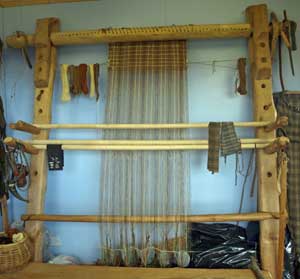 | 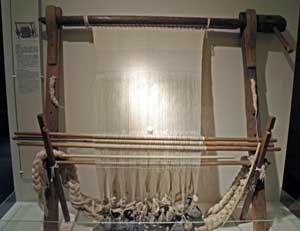 | 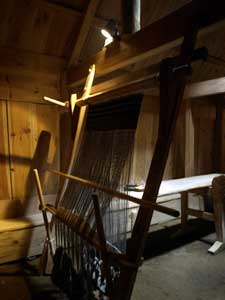 |
| Old Scatness, Scotland Likely 1800's? | National Museum of Iceland Perhaps 1700's? | Stong Farmstead, Iceland Modern reconstruction |
Images above by Karen Peterson
After considerable discussion, it was decided to build a new loom. The key was to not only consider the artifact prototypes available, but also the raw materials available on hand in both Iceland and Vinland circa 1000 AD. One primary problem in looking at the existing samples is that all of them are at best no older than the 1700's. Almost all have been heavily restored. A good number of those on display in museum collections are in fact modern replicas. Our own textile workers have been known to be puzzled by some of those on display. "Well, that just will not work!" is a repeated comment. (Few museum displays are actually set up by involved workers in the related skills, see any of my earlier comments on blacksmithing exhibits.)
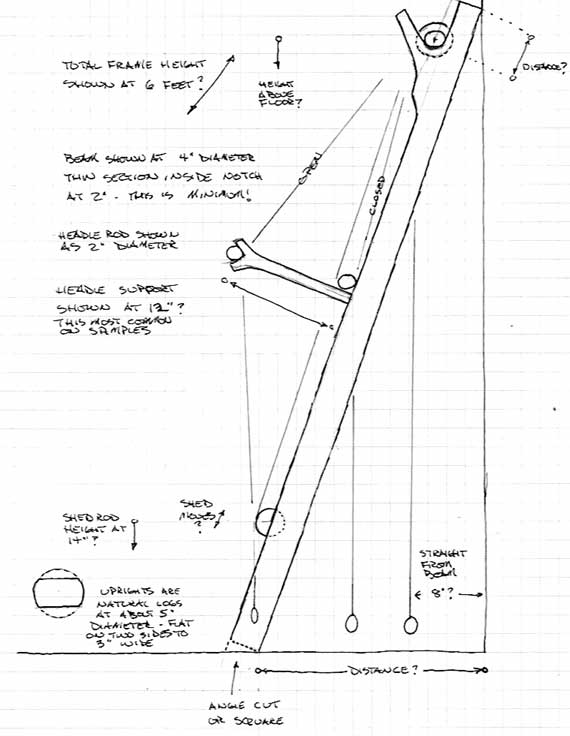
The primary difference between the more 'continental' style and a distinctively 'Icelandic' style of loom appears to be in the difference in how the heddle bar is supported. (The heddle bar is the horizontal rod to which one set of the up and down warp threads are attached.) The more commonly used method in most re-constructions I have seen uses the form seen on the Old Scatness sample. That is a pair of forked branches or notched boards, which fit into a series of holes running along the uprights. This arrangement allows for adjusting the distance and position of the heddle rod, and thus controls the width of the shed (distance between front and back warp threads). This arrangement is physically quite strong, as the considerable force caused by supporting the loom weights will push straight back down the shed support rods and back into the frame.
On the Icelandic pattern, the heddle supports are two longer poles or planks, wedged between the floor and the lower horizontal line of the shed support. The advantage of this method is both ease of construction and that it is almost infinitely adjustable. The major problem is that now the force of the loom weights is directed in a diagonal line against the side of the shafts.
In truth, as the major elements of the frame of the loom are virtually identical, it was decided to design the new loom to allow it to be mounted up for either method. There would be the required holes drilled in the uprights and a set of forked shed supports, plus the longer and heavier rods included to set up for the Icelandic tradition.
In all the 'artifact' samples, the two uprights have been flattened off on two sides. The supporting fork at the top of the uprights (for the top beam) are made of separate pieces, cut to shape and pinned into place. This is a significantly weaker construction method, as the load runs across the direction of the grain, and all the weight is entirely born by the two pins. A better method is to use two natural limb joints, where the grain will run around the fork and so is significantly stronger. The ideal way to attach these as separate pieces would be to set them into a large dovetail joint. (Readers will note that this is Evil Wood talk : 'I said I don't have much use for them, not that I don't know HOW to use them'.) In the end I decided to use one piece naturally forked limbs to ensure strength but reduce complexity.
The next concern was about materials, and how these might fit into our proposed scenario for DARC at Vinland. Initially it was suggested that 'Ka∂lin' would be a 'professional' weaver, and as such would likely have brought her loom with her on the immigration trip from Iceland. Karen, however, was a bit concerned that this story element might overplay her actual weaving skills. As a compromise, it was decided that the loom she would would work on at LAM would be one that could have been constructed at Vinland itself, perhaps skillfully built (?) but of available local materials. Birch was chosen, as it was available in both Iceland (still) and Vinland circa 1000 AD.
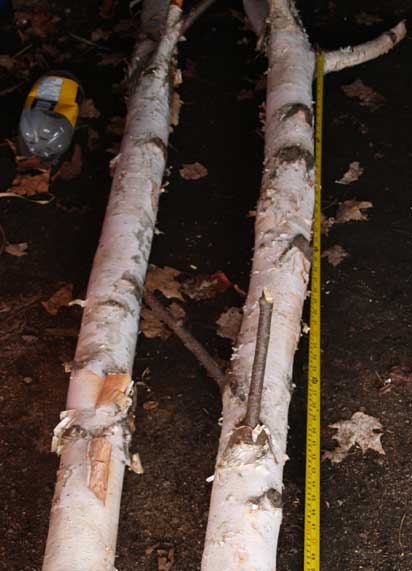
To that end, in mid March I wandered off into a local woodlot (where I have permission to cut). After three hours slogging around in mushy snow and melt water pools, I selected two standing birch trees to fell. This proved much harder than it might seem, I looked a dozens of trees through the swampy area. The key was finding two in the right size range (5 - 6 inch diameter) with naturally occurring forks in the correct configuration. Even cut down to an eight foot length, a six inch green log is damn heavy! I also gathered a standing but long dead (and dry) spruce sapling. This piece is dead straight, and tapers evenly from 3 1/3 inches at the base through to about 3/4 an inch - over a 23 foot length. I ended up making a second trip into the bush later to return to the cutting sites to gather smaller diameter forked branches to use for the shed supports and beam winding shafts.
The first step was removing all the bark. To keep the whole project looking as 'authentic as possible, this work was done using a hand axe. The smaller existing branches would be trimmed back to short lengths, providing a number of natural hooks for eventual hanging of weaving tools.
Special attention was given to the method of cutting the ends of the top beam. These ends would be clearly visible. So they were cut more or less flush by using the hand axe and a mallet. This does leave an entirely different finish than slicing off with a modern saw.
YouTube segment showing the preparation of the raw logs.
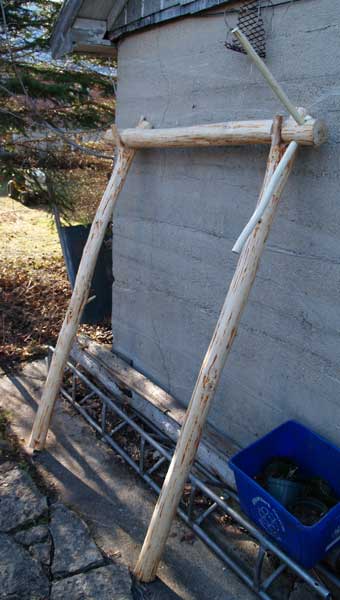 | 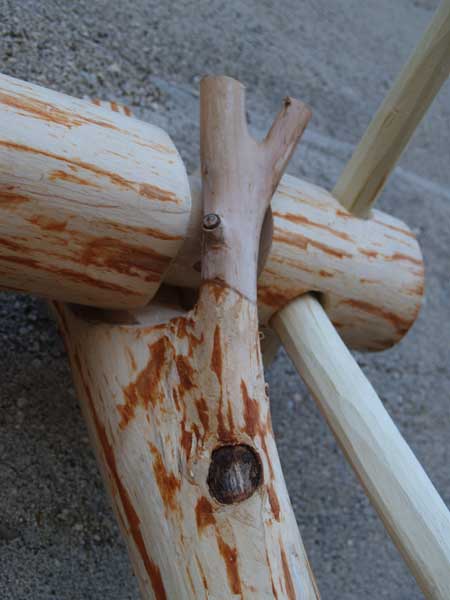 |
| Frame under construction | Detail of beam and upright |
The images above show the majority of the loom's frame completed.
BELOW : The completed loom. You will see it has three positions for the lower shed support. There are a total of 4 positions for the heddle support rods. (You may notice this is the more standard layout, the two longer pole pieces for the Icelandic method will be made up later.)
 ≈
≈




















1 comment:
Where can I find an image of the Icelandic style heddle rod support? I cannot picture what you mean by your written description.
Post a Comment